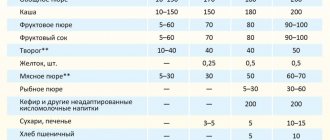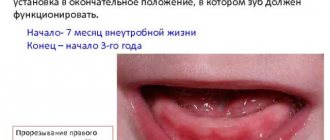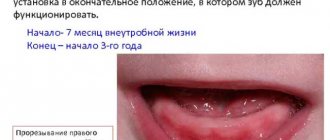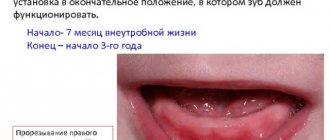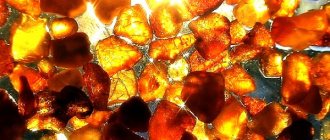There are happy parents and children who may not even notice how a new tooth has appeared in the child’s mouth. But still, more often than not, when teething, both the baby and the parents are equally worried and do not sleep at night. In some cases, the baby’s temperature can rise to 39 degrees; it is imperative to react to such a high temperature. Parents need to know what to do in such cases and when to use professional medical help without trying to self-medicate.
What causes fever to rise during teething?
Contrary to the popular belief of parents, an increase in temperature on the teeth is not the norm and does not always accompany teething. In this way, the baby’s fragile body responds to the occurrence of an inflammatory reaction in the gum, through which the first tooth makes its way. In this place, immune defense is reduced, microorganisms living on the mucous membranes are activated - this also provokes temperature surges.
This process is most difficult after a year, when fangs or molars are being cut, since the chewing teeth have several tubercles that cannot appear simultaneously and the process sometimes drags on for up to several weeks. The “eye” teeth are located slightly deeper than the others and must travel a longer path to the gum surface. Therefore, children usually experience quite severe discomfort and prolonged rises in temperature when they appear.
Sometimes fever during this period of life is a sign of an acute infection, which is due to reduced immunity. In this case, the body tries to protect itself from the invasion of viruses or bacteria and increases the temperature, which is destructive for pathogens.
What not to do when teething
It’s hard to look at a child when you know that he’s feeling bad right now. Therefore, many parents try to take some measures to somehow help their child. But not everything goes to his advantage. During the teething period, you cannot rush the course of events. Teeth will erupt in any case. If you try to speed up this process, you can only do harm.
What not to do:
- give adult medications to bring down the temperature;
- wipe the child with vinegar or alcohol;
- massage the gums;
- make cuts on the gum so that the tooth emerges faster;
- give the child dry bread crust (it can scratch the swollen tissues in the mouth and infection can penetrate through the wounds).
Now in children's stores there are a sufficient number of various “rodent” toys, as well as pain-relieving gels that will help simplify the teething process and reduce pain and inflammation. It is to them that you need to resort if there is a need to help the baby.
“Rodents” for teething children
What is the maximum temperature possible during this period?
How much the temperature rises when a baby’s teeth appear depends only on his individual characteristics. On average, this figure is 37.5-37.7 degrees. Sometimes this figure can reach 38 - this is also an acceptable value. It is important to take regular measurements, since infants do not regulate heat exchange well and as inflammation progresses, the temperature can increase very quickly.
A higher temperature (39-40 degrees) may indicate complications, the development of a respiratory tract infection and requires immediate medical attention.
What is the maximum permissible body temperature of a child during the formation of teeth?
How high a baby's body temperature can rise depends on the condition of his body. During teething, a normal body temperature is considered to be between 37.5 and 37.7 degrees. The maximum permissible temperature is 38 degrees. If it increases further, then measures should be taken to reduce it.
Parents should remember that during the period of formation of baby teeth, the child’s body temperature should be measured more often.
If the child’s body temperature reaches 39 - 40 degrees, this means that urgent medical attention is needed, since, most likely, the infection has penetrated the baby’s respiratory system.
How many days does it last
In answering this question, it should again be recalled that all children are different and react differently to the appearance of teeth. On average, fever in babies can last 1-3 days and usually disappears immediately after teething.
But in the experience of many pediatricians, there are children whose high body temperature associated with the appearance of their first teeth lasted up to 4-5 days. Or there are cases when the fever lasts only a few hours and goes away without any intervention. In any case, you should not delay consulting a doctor, since if you have any diseases, identifying them earlier has a more favorable outcome.
Why does the temperature rise
Such a characteristic sign during the formation of masticatory organs as temperature occurs in 50-70% of children. It can appear every time teeth are cut, or maybe only in isolated cases. Most fathers and mothers face a “bouquet” of problems during the “birth” of teeth, including the appearance of hyperthermic syndrome. In fact, it is a shield for the active release of specific substances. To extinguish pathology, the body needs energy and resources. Provoking factors:
- The baby does not have fully formed life support systems, so they malfunction as soon as a provocateur appears.
- Heat exchange in the body is disrupted, which affects temperature indicators.
- Decreased appetite and sleep disturbance weaken the toddler’s body even after a year.
All this weakens the overall immune system. In such conditions, pathogenic microorganisms ideally multiply. To prevent this, body temperature rises. Therefore, the fact that the temperature has increased is quite natural. If there are no complications, there is no need to be afraid. But sometimes, when teeth appear, secondary diseases develop. This happens when the protective functions do not work and bacteria actively continue to multiply. Depending on where the infection is localized, the following ailments appear:
- Stomatitis or gingivitis
- Tonsillitis, adenoiditis or pharyngitis
- Laryngotracheitis or bronchitis
- Enteritis or dysbacteriosis
In order to clarify the reasons, you need to consult a pediatrician. If he recommends lowering the temperature during teething, then he will prescribe certain medications. The mother must constantly monitor the baby. It must be remembered that children react differently to deterioration in well-being. Therefore, parents should monitor their child’s behavior.
Other symptoms accompanying fever
During teething, there may be other symptoms in addition to fever. Swelling of the gums can spread from the oral cavity to the nasal mucosa, thereby causing a slight runny nose and the discharge of a slight transparent mucous secretion. This symptom is more pronounced when the upper teeth erupt.
The appearance of baby teeth is often accompanied by excessive salivation, especially when the lower teeth erupt. This also causes a slight loosening of the stool - the stool becomes a little softer than usual.
What should parents be wary of?
A child's body, weakened by teething, is very susceptible to bacterial or viral infection. Therefore, the baby’s symptoms may indicate complications:
- Severe nasal congestion , accompanied by copious discharge of purulent secretion. This suggests that on top of the usual swelling of the mucous membrane there is rhinitis, which must be treated.
- Loose stools . Fever and diarrhea together rarely accompany the appearance of teeth. This symptom may indicate the presence of some kind of intestinal infection, which the child could have introduced into the body with toys or gum teethers.
- Cough . With excessive salivation, children do not always have time to swallow saliva in time and sometimes choke on it, which causes periodic coughing. If the cough is systematic, accompanied by difficulty breathing or sputum discharge, then this speaks in favor of inflammation of the respiratory tract.
- Red throat . The inflammatory reaction that occurs in the gums during teething cannot spread to the mucous membranes of the throat. Redness of the palatine arches or pharynx is a sign of pharyngitis or acute respiratory infections.
- Vomiting often accompanies high body temperature in young children. But it may be a sign of damage to the nervous system or intestinal infection.
The presence of such signs requires urgent medical attention and appropriate treatment, regardless of what temperature (high or low) accompanies them.
Symptoms of canine eruption
In order for parents to be able to determine that this is a child’s temperature during teething, and not a symptom of a disease, you need to know how children’s bodies most often react to tooth growth.
Regardless of whether there is a high temperature or not, copious amounts of saliva are always produced. Due to constant discomfort in the oral cavity, the child becomes capricious and irritable. Babies sleep very poorly during this period and often wake up at night crying loudly, after which they cannot calm down for a long time.
During the period of time when the baby’s fangs and other new teeth appear, the child begins to put absolutely everything into his mouth. To reduce the risk of a large number of bacteria getting into the stomach and oral mucosa, it is worth giving the baby special rubber toys. There are great options that can not only speed up teething, but also cool your gums. This has a fairly strong analgesic effect.
A sign that a child is teething can also be a deterioration in appetite. This is associated not only with high fever and deterioration in general health, but also with severe discomfort in the mouth. Sometimes redness appears on the child's face, which can be confused with an allergic reaction.
All this is a sign that the baby is teething. But often such symptoms become a manifestation of various diseases. Therefore, you should always be as careful and attentive as possible to the health of your child.
Temperature during loss of primary teeth and eruption of permanent teeth
The replacement of baby teeth with molars is usually not accompanied by any temperature reactions. An exception may be chewing teeth, which have a large surface and cause significant inflammatory reactions in the gums.
In addition, an increase in temperature during teething in a fairly old child (6 years of age or more) may indicate the presence of gingivitis - a disease of the gingival mucosa, which can lead to serious consequences without treatment.
Child's body temperature when replacing baby teeth with permanent ones
During the period of loss of baby teeth and the appearance of permanent teeth, the child’s body temperature remains normal. Only some children's body temperature rises when permanent molars begin to form. The reason for this is the size and shape of the molars.
Typically, children's first permanent teeth begin to form at the age of six. If at this time the child’s temperature rises, then there is a possibility of gingivitis. This disease is characterized by inflammation of the mucous membrane of the gums and requires treatment.
What to do when the temperature rises
Often parents, even with a slight fever, begin to actively treat the child with antiviral, antipyretic and antibacterial drugs. Even if this symptom is due to the appearance of the first teeth. Most pediatricians (including Dr. Komarovsky) are against such radical methods. Why shouldn't you do this?
A temperature of 37 degrees and above is a kind of protective reaction of the body and helps it more actively produce antibodies against viruses and bacteria. Low body temperature does not allow you to effectively fight infection. Therefore, sometimes it is worth not interfering with natural processes and immediately suppressing even minor signs of fever.
But you shouldn’t fall into inaction either. If the fever reaches significant numbers (38 degrees or higher) and is accompanied by a change in the general condition of the child, then prescribing antipyretic drugs for high fever is a primary measure.
If the rise in temperature is not controlled by conventional medications, then it is possible to scrub the child with cool water or an vinegar-alcohol mixture.
If the fever does not subside within 3 days, then you must definitely visit your treating pediatrician to decide on further examination and the possibility of prescribing antibiotics or other medications.
Some parents prefer homeopathy in such cases. Such drugs do not effectively reduce the temperature, but they can alleviate the baby’s general condition and speed up the recovery process. A prerequisite before taking homeopathic medicines is to consult a specialist.
Is it possible to lower the temperature and when to call a doctor?
When the baby is restless, the mother is also worried. There are many alarming symptoms, one of them is a temperature higher than 38.5 degrees. Doctors recommend knocking it down, especially if it rises in the evening. It is necessary for the little one to rest well during the night. In addition, the maximum temperature must be reduced if:
- The baby’s health has deteriorated significantly, he began to sleep a lot, he is not interested in toys, the baby cries for a long time;
- Rapid breathing and irregular heartbeat appeared;
- Convulsions develop;
If convulsions appeared earlier, then you should not wait for readings of 38.5°. Measures are taken in case of convulsive readiness. The child's condition will improve if:
- Maintain the temperature in the room to 18°;
- Wipe your face with a damp cloth;
- Wipe the body with a damp swab every 2 hours;
- Wrap the baby in a diaper moistened with water;
Children over 5-6 months are given water without restrictions. Pediatricians prescribe Ibufen or Panadol, Efferalgan or Nurofen. The drugs are used in suppositories or in the form of syrup. The syrup produces quick results, but does not last long. The candles do not work immediately, but the effect lasts for a long time. Medicines are given as prescribed by the doctor.
Sometimes the high temperature does not go down. To help your baby, you should contact your pediatrician:
- At a temperature of 39.5° – 40°;
- After normalization of indicators, they quickly increase;
- When maximum values are observed for a day, two or longer;
- If the skin turns pale, the child groans and is passive to everything;
- With the development of vomiting and severe diarrhea;
If symptoms increase, you need to call an ambulance.
Is it possible to walk with a child with a fever?
If the baby’s general condition does not suffer much during teething, and the temperature is not high and is well controlled by antipyretic drugs, then a walk may even be beneficial. The main thing is to dress your child according to the weather, try to stay away from other children (since you can easily catch an infection) and not tire your baby with active outdoor games.
If the fever reaches high levels and the child does not tolerate it well, then it is better to refuse a walk until the condition improves.
In any case, even if parents are sure that the increase in temperature is caused by teething, medical consultation is necessary. You should not self-medicate, since incorrect measures will not only not alleviate the baby’s condition, but can also harm his health.
What causes body temperature to rise during the formation of baby teeth?
There is a misconception that a child’s elevated body temperature during the eruption of baby teeth is not normal and therefore measures should be taken to lower it to a normal level. In fact, this is not so. The fact is that at the site of tooth eruption, the body’s immune defense decreases. Harmful bacteria enter the disturbed gum and cause an inflammatory process, which is always accompanied by an increase in body temperature. It should be understood that elevated temperatures have a detrimental effect on harmful microorganisms. Of course, this does not mean that excessively high temperatures during teething are normal.
Parents of the baby should not worry if, during the formation of baby teeth, the baby’s body temperature does not exceed 38 degrees.
In one-year-old babies, the process of tooth formation is much more complicated. It is after the first year of life that a child’s canines and molars begin to form. These teeth erupt much more slowly and, accordingly, increased body temperature can persist for a long time. Their long formation is explained by the uneven shape of the molars and their size. Sometimes it lasts several weeks.
The same situation occurs during the eruption of eye teeth. Their roots are located much deeper than the rest of the baby's teeth. Therefore, the growing eye tooth has to travel a longer path to the gum surface. All this time, the child experiences discomfort, and his body responds to it with an increase in body temperature.
In essence, the emerging baby teeth tear the soft tissue of the gums, and this cannot be painless. In this place, the immune defense is weakened due to injury. During the formation of molars, children often develop a fever. This happens when the impact of harmful microorganisms becomes too powerful, that is, an infectious infection has occurred. In this case, the body temperature rises to 38 degrees, and sometimes above.
